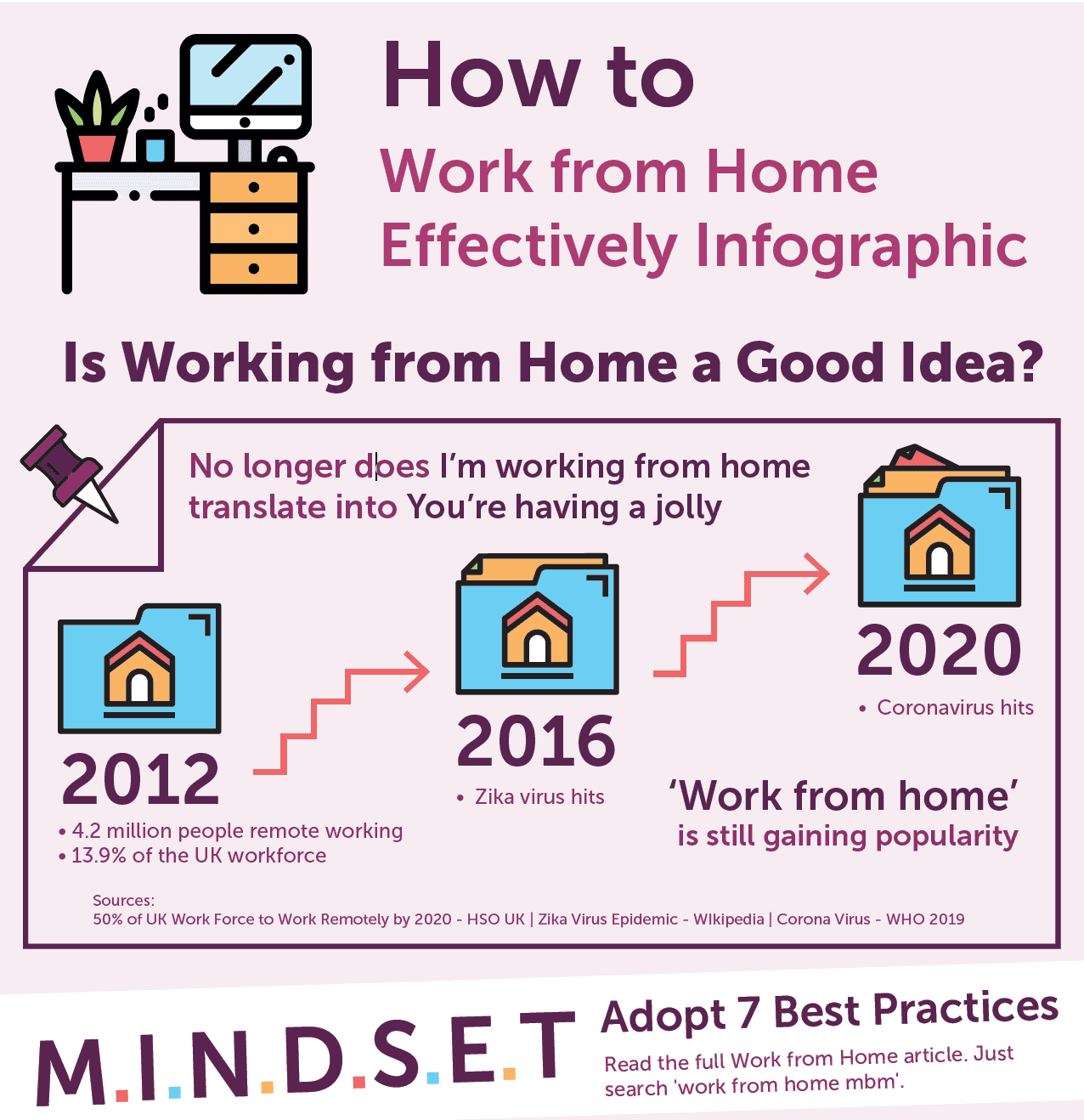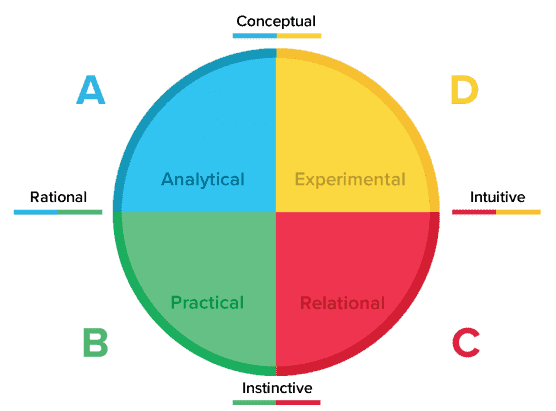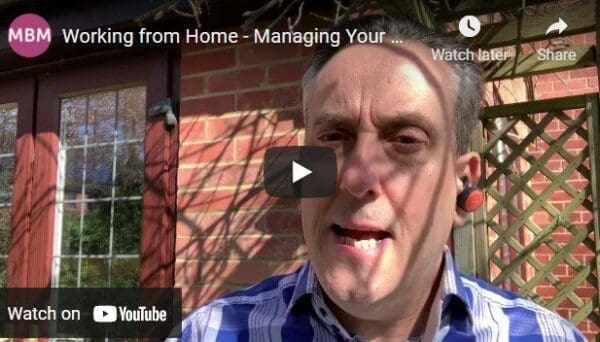Work From Home: Mindset – I is for Isolation
The second letter of our mnemonic M.I.N.D.S.E.T. specifically designed to help you work from home better is ‘I’, Isolation.
Work From Home: Isolation Best Practice
Get out. Go to a coffee shop. Meet a friend for breakfast. Walk into town. This must become part of your weekly routine to look after your well being. As a minimum every two weeks (Obvious only some apply during the Coronavirus lockdown).
Read the main article: How to Work from Home Effectively – M.I.N.D.S.E.T. – Adopt 7 Best Practices.
Stage 1 – Guilty-Freedom…
In the first few weeks, you’ll be in the honeymoon period. It will feel a bit like when you bunked off from school with a pretend cold. The house to yourself. No-one watching over you. The tv is all yours. The world is your oyster. Bottle of Lucozade with the gold foil top, left by your Mum with instructions, ‘Drink this’.

You’ll also feel a sense of guilt in the first few weeks of working from home because, at the end of the day, you’re an adult paid to do a tough job. And you’ll swing from freedom to guilty and back again.
Stage 2 – Busy, Busy, Busy
The second stage is busy, busy, busy. This is where you realise that you can get so much done. There are no distractions. No-one standing at your desk. You can ignore the phone. Woohoo! And combined with a means to counteract the guilty feeling from stage 1, you work hard. You get so much done. Possibly working yourself into the ground.
Stage 3 – Strike a Balance
The third stage is balance. You’ve made the mistakes, learnt the lessons, and started to find some balance in how you work from home. Bear in mind that some people never get out of stage 1 or stage 2!
During stage 3 you’ll start to feel isolated. Working at home has lost its fanfare, and it is now about discipline. You are pretty comfortable that you can get the work done, and largely achieve a resemblance of work/life balance. This is where you look up, after the initial reaction to change, and notice that everyone has gone.
I remember in my first year of remote working – I had started working from home in March. We went on a family holiday in July to Lanzarote. I knew nothing about the 3 stages then. We had been away for two weeks. Sunday night, I got ready for work the next day. At 7.30 am on Monday morning I walked into my office (My ‘office’ was a converted garage attached to the house).
For some reason the previous owners had put mirrors in the garage – I think he’d had a gym in there. I remember walking to my desk, catching sight of myself in the mirror and feeling sad that there was no-one to say, ‘Nice tan’. No chit chat about the snorkelling. No, ‘You look well’. I had to just crack on.

The Key to Isolation From Home
It’s actually easy to say, but hard to do. Don’t isolate yourself. It’s hard to overcome because you’ll want to ‘get your head down’ and work. After all, that’s what you are paid to do. But remember that ‘you working’ is about ‘you being productive’ and ‘you being productive’ is about ‘you being happy’.
You have to get out or you will get cabin fever. The term ‘cabin fever‘ comes from the early American pioneers who spent long winters on the Great Plains in the 1900s. Whilst you are not truly alone. You have Skype. And you have many virtual platforms that always seem to want to get in touch. The but is – You’ll want to be with people. Don’t get lost in your cabin.
Take advantage of what working from home has to offer. It can be a great gift if you use it right. Working from home you can:
- Meet a mate for breakfast.
- Take your spouse out to lunch.
- See the kids’ Christmas play.
- Watch your child win the sports race.
- Go to the school parent’s evening.
- Finish early and go to an early screening at the cinema.
- Work by a lake on a bench.
Add one of these into your schedule every 2 weeks.
(Click on the image below for the extended version)

HBDI®
Founded by Willian ‘Ned’ Herrmann, HBDI® (Herrmann Brain Dominance Instrument) is a psychometric assessment tool that identifies an individual’s thought preferences. Often referred to as the ‘whole brain model’, it comprises a 120-question survey which identifies thought characteristics in the following four quadrants:

- A – Blue quadrant: Logical, technical, and financial. In a single word ‘fact’, or as a profession – Engineer.
- B – Green quadrant: Organised, detailed, and structured. In a single word ‘form’, or as a profession – Project Manager.
- C – Red quadrant: Emotional, sensory, and people. In a single word ‘feeling’, or as a profession – Teacher/Nurse.
- D – Yellow quadrant: Risk taker, intuitive, and the big picture. In a single word ‘future’, or as a profession – Entrepreneur.
By understanding your thought preferences, you can achieve a greater appreciation for how you learn, which in turn helps decision making, problem-solving, and communication.
How Can HBDI® Support You?
By understanding yourself and your colleagues better, you can tailor your communication for example, towards individual’s needs. The challenge, however, and especially when working from home is communication is often only verbal, as opposed to verbal and visual, making it increasingly important get the message across right, the first time. So working on those less dominant quadrants, and using the strengths of the people in your team to be ‘a whole-brain’.
You can read more about HBDI ® in our Ultimate Guide.
Leadership coaching and development is important to grow your talent and retain your people.
I – Isolation Best Practice
Get out. Go to a coffee shop. Meet a friend for breakfast. Walk into town. This must become part of your weekly routine to look after your well being. As a minimum every two weeks (Obvious only some apply during the Coronavirus lockdown).
Emily Lofting-Kisakye MCIPD:
Working from home – is it the more comfortable option or actually more uncomfortable due to isolation?
I have experienced home working for the last 8 years, learning how to communicate when remote and how to build in routine to make each day a success. It takes time, trial and error and honesty to yourself to make it really work well without impacting relationships that are built via face to face contact.
Working from home in a normal environment is one thing
Working from home in a forced way during a global pandemic as we are now is very different. It can conjure the feelings of worry, displacement and overall lack of direction in this current climate. Being alone every day every week for an indefinite period of time is a challenge to all and isn’t something all of us would choose but are now faced with.
Lots will be now and have been, said about establishing a daily routine to ensure workflow and productivity remains high and that is all true but without understanding yourself and your own triggers and motivators working from home all the time for a long time won’t be as effective as it can be.
Taking reflection time to understand your energy high points and low points in the day will help you to plan the best times for breaks, for background noise and for exercise. These high and low energy points may well be different when alone as opposed to being within a team so taking some time to analyse this and build a routine around it will pay dividends.
Becoming easily distracted is something that is often overlooked in the initial period of working from home – from home means all of your household chores and comforts are there all day with you which you do not have in an office environment. There are helpful apps like Forest that can help focus your attention and ensure you are maintaining a good level of productivity; that combined with a clear routine that works for you as an individual will help a lot.
Everyone is an individual
Understanding that your thought process and energy level peak is not the same as others will really help you to connect with people remotely at the most effective time for you and them. For example, if you have a similar energy level drop to other people in your team a scheduled video call at that time could help boost you both/all for the next part of the day.
If you have been lucky enough to understand your personality type and those of the team around you lean on this heavily to understand the ways people may be processing and feeling during this time to help work with them remotely in the best possible way.
In summation
Home working is a wonderful workplace evolution that needs with it a trust that presenteeism isn’t lost and productivity remains high. For some, it is the more comfortable and happy option but not for all and we cannot lose sight of that. For it be successful and effective for you and your business remember who you are, schedule your day according to your natural energy flow and set your boundaries as you would in an office regarding distraction and working hours.

6 M.I.N.D.S.E.T. Best Practices
Read the main article: How to Work from Home Effectively – M.I.N.D.S.E.T. – Adopt 7 Best Practices.
M is for Manage: Learn how to manage yourself working from home.
N is for Neat: Know why staying in your pyjamas all day will affect how you feel about work.
D is for Deliverables: Find out why you are on the payroll and where to start investing in you.
S is for Space: Getting your own space when you work remotely is very important. Find out how and why.
E is for Emotions: Read about why you need to articulate how you feel.
T is for Technology: Technology is the foundation of your productively. See how to ensure that it is up to the job.
Additional Resources to Help
The top 10 advantages and disadvantages of working from home.
Advice from Vincent Hickman, Business Manager at Greencore:
-
- When working from home you require discipline, you need this in bucket loads.
- Start on time and finish on time. Even though you’re at home, you are still at work.
- Do the hard jobs first and save the easier ones for later in the day when you’re starting to flag.
- Stay in contact with your colleagues. Use Skype, MS Teams, Phone, Facetime etc. whatever works for you to stay connected and in touch.
-
Lastly, don’t feel guilty for taking a coffee break or lunch break.




